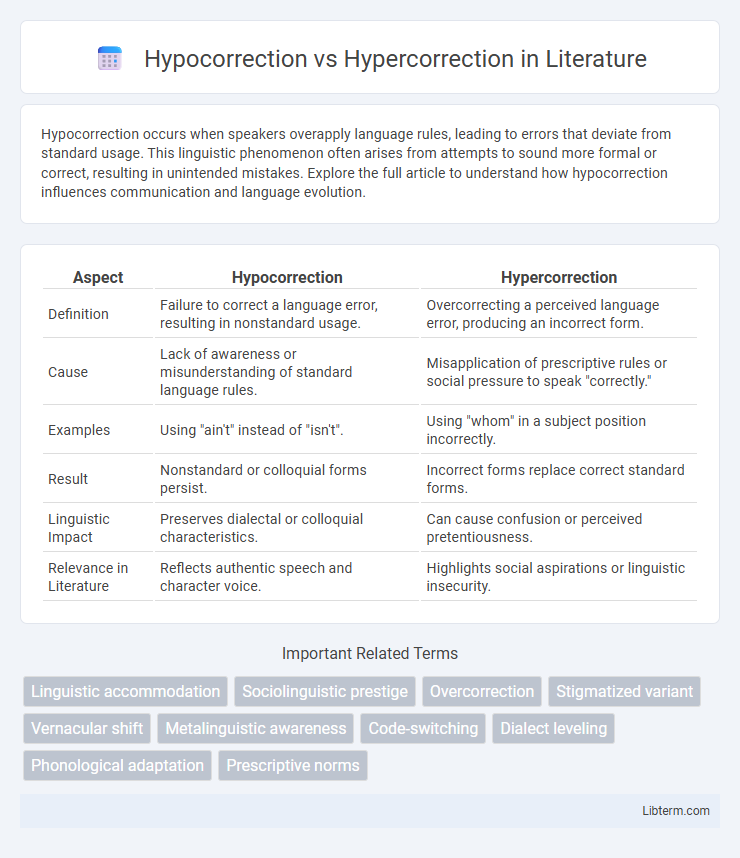Hypocorrection occurs when speakers overapply language rules, leading to errors that deviate from standard usage. This linguistic phenomenon often arises from attempts to sound more formal or correct, resulting in unintended mistakes. Explore the full article to understand how hypocorrection influences communication and language evolution.
Table of Comparison
| Aspect | Hypocorrection | Hypercorrection |
|---|---|---|
| Definition | Failure to correct a language error, resulting in nonstandard usage. | Overcorrecting a perceived language error, producing an incorrect form. |
| Cause | Lack of awareness or misunderstanding of standard language rules. | Misapplication of prescriptive rules or social pressure to speak "correctly." |
| Examples | Using "ain't" instead of "isn't". | Using "whom" in a subject position incorrectly. |
| Result | Nonstandard or colloquial forms persist. | Incorrect forms replace correct standard forms. |
| Linguistic Impact | Preserves dialectal or colloquial characteristics. | Can cause confusion or perceived pretentiousness. |
| Relevance in Literature | Reflects authentic speech and character voice. | Highlights social aspirations or linguistic insecurity. |
Introduction to Hypocorrection and Hypercorrection
Hypocorrection occurs when speakers fail to adjust their language in formal contexts, often resulting in errors that reflect informal or nonstandard usage. Hypercorrection involves overapplying perceived rules of standard language, leading to mistakes such as using incorrect grammar or pronunciation to sound more prestigious. Both phenomena highlight the complex interaction between language norms, social identity, and linguistic competence.
Defining Hypocorrection
Hypocorrection occurs when a speaker uses a nonstandard linguistic form that deviates below the expected or normative level, often due to incomplete learning or influence from colloquial speech. This phenomenon contrasts with hypercorrection, where a speaker over-applies linguistic rules aiming for correctness but ends up producing a nonstandard form. Understanding hypocorrection is essential in sociolinguistics and second-language acquisition for analyzing language change and speaker identity.
Defining Hypercorrection
Hypercorrection occurs when language users over-apply grammatical rules or pronunciation patterns in an attempt to speak or write correctly, often resulting in errors that sound overly formal or incorrect. This phenomenon is common in second-language learners and speakers trying to avoid stigmatized dialect features, leading to mistakes such as using "whom" incorrectly or mispronouncing words based on hyper-aware rules. Hypocorrection contrasts by involving under-application or neglect of standard language norms, producing casual or colloquial speech deviations.
Linguistic Contexts of Hypocorrection
Hypocorrection occurs when speakers underapply a linguistic rule in contexts where the standard form is expected, often resulting from familiarity within informal social networks or dialectal influences. In linguistic contexts, hypocorrection is common in casual conversations where speakers maintain vernacular pronunciations or syntactic structures despite exposure to standard language norms. This phenomenon reflects sociolinguistic identity and resistance to prescriptive language forms in everyday speech patterns.
Linguistic Contexts of Hypercorrection
Hypercorrection in linguistic contexts occurs when speakers apply perceived language rules erroneously, often to sound more prestigious or correct, resulting in nonstandard forms such as "between you and I" instead of "between you and me." This phenomenon typically arises in social settings where speakers are highly aware of language norms yet lack full mastery, leading to overgeneralization of grammatical rules. Hypercorrection contrasts with hypocorrection, where speakers neglect formal language norms, reflecting different sociolinguistic motivations influencing language use and variation.
Common Examples and Case Studies
Hypocorrection occurs when speakers underapply linguistic rules, such as using "ain't" instead of "isn't" in informal contexts, reflecting casual speech patterns in African American Vernacular English (AAVE). Hypercorrection happens when speakers overapply prescriptive rules, evident in cases like pronouncing "whom" incorrectly as "who" in formal speech to avoid appearing uneducated, documented in studies of English language learners. Case studies in sociolinguistics reveal these phenomena highlight identity negotiation and social status awareness within language communities.
Psychological Factors Influencing Correction
Psychological factors influencing correction involve individuals' perceptions of social identity and the desire to conform to perceived prestigious language norms, which often lead to hypercorrection as speakers over-apply linguistic rules to avoid stigmatization. Hypocorrection occurs when speakers downplay or ignore standard language forms, usually due to limited awareness or motivation, reflecting a subconscious alignment with in-group dialects. These cognitive and social motivations shape how people modify their speech patterns in response to social pressures and self-concept.
Social Implications of Language Correction
Hypocorrection and hypercorrection have significant social implications, influencing perceptions of education, class, and identity within communities. Hypocorrection occurs when speakers fail to adjust their language in formal contexts, often leading to judgments of lower social status or lack of education. Hypercorrection involves over-applying perceived 'correct' language norms, which can result in social distancing or stigmatization by signaling insecurity or social aspiration.
Strategies to Balance Correction in Communication
Effective communication requires balancing hypocorrection and hypercorrection by adopting strategies such as context-sensitive language use and active listening to avoid misunderstandings. Employing adaptive feedback mechanisms helps speakers adjust their language to match the audience's expectations without over- or under-correcting. Training in sociolinguistic awareness enhances the ability to gauge when formal or informal language is appropriate, promoting clearer and more respectful interactions.
Conclusion: Choosing Between Hypocorrection and Hypercorrection
Hypocorrection involves under-adjusting language use, often maintaining nonstandard forms for social identity or ease, while hypercorrection leads to over-adjustment, producing uncommon or erroneous forms due to perceived prestige. Selecting between hypocorrection and hypercorrection depends on context, with hypocorrection favoring authenticity and naturalness, and hypercorrection aiming for social acceptance and correctness. Effective communication balances these adjustments to reflect speaker intent, social norms, and linguistic accuracy.
Hypocorrection Infographic

 libterm.com
libterm.com